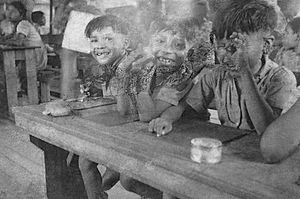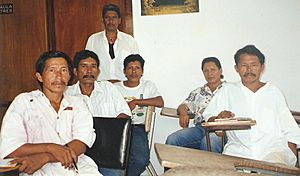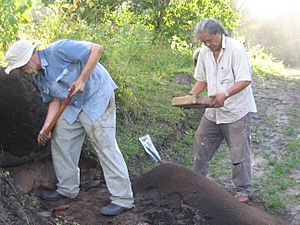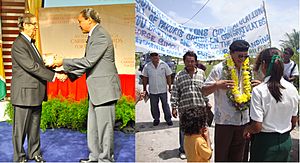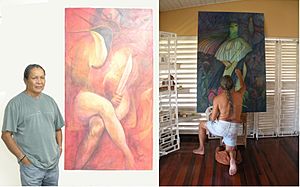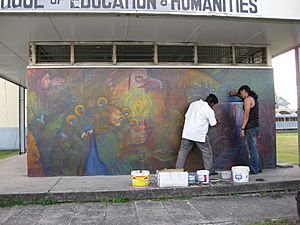George Simon (artist) facts for kids
Quick facts for kids
George Simon
|
|
|---|---|
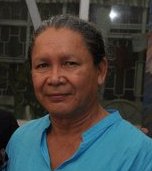 |
|
| Born | 23 April 1947 St. Cuthbert's Mission, British Guiana (now Guyana)
|
| Died | 15 July 2020 (aged 73) Canary Islands, Spain
|
| Nationality | Guyanese |
| Alma mater |
|
| Occupation |
|
| Known for | His paintings, the Berbice Archaeology Project, founding the Lokono Artists Group |
|
Notable work
|
|
| Awards |
|
George Simon (born April 23, 1947 – died July 15, 2020) was a famous Guyanese artist and archaeologist. He belonged to the Lokono Arawak people.
George Simon started the Lokono Artists Group. This group helps Lokono artists from Guyana, especially those from his hometown, St. Cuthbert's Mission. Many people saw him as one of the best Guyanese artists of his time. His paintings often showed Amerindian culture and the beautiful environment of Guyana. He was also known for being a great teacher and for helping other Amerindian artists.
Life Story of George Simon
Growing Up in Guyana
George Simon was born on April 23, 1947. His parents, Olive and Mark Simon, lived in St. Cuthbert's Mission in British Guiana (now Guyana). His father was a woodcutter, and his mother took care of their home.
George went to school in St. Cuthbert's Mission until he was 12. He later shared that the school discouraged Amerindian culture. For example, if students spoke their native Arawak language in class, they would be punished. This made Amerindian culture seem less important.
When George was 12, an English priest named James William Pink adopted him. George then moved to Linden and later to Georgetown. He studied many subjects, including art, at Christ Church Secondary School.
Studying in England
In 1970, George Simon moved to Essex, England with his foster-father. He studied art at Thurrock and Basildon College from 1972 to 1974. Then, in 1975, he went to the University of Portsmouth. There, he earned a degree in fine art, focusing on art history. He graduated with honors in 1978.
Returning to Guyana
In 1978, George Simon came back to Guyana. He started teaching art at the Burrowes School of Art and later at the University of Guyana. During this time, he became good friends with Denis Williams, a Guyanese archaeologist and writer.
In 1985, Williams invited George to work at the Walter Roth Museum of Anthropology. This is where George began to learn about archaeology (studying old human history) and anthropology (studying human societies and cultures).
Exploring Guyana and Its Cultures
As part of his work at the Walter Roth Museum, George went on many trips across Guyana. These trips greatly influenced his life and art. Soon after joining the museum, he led a trip to a Wai-Wai village called Sheparyimo. He spent a month there, learning about the Wai-Wai people.
During this visit, George drew many sketches of the Wai-Wai people, their homes, and their tools. These experiences inspired a series of paintings called the Wai-Wai Series. He also traveled a lot on the Essequibo River, which led to his Essequibo Series of paintings.
George later said that these trips helped him connect with his own Amerindian heritage. He felt "reunited with [his] people" and could explore his "Amerindianness" through his art.
Starting the Lokono Artists Group
George Simon also worked hard to help other Amerindian artists in Guyana. He noticed that many young people from his village didn't go far in their education. So, in 1988, he started a drawing and design workshop in St. Cuthbert's Mission.
This workshop helped many talented artists, including Oswald ("Ossie") Hussein, Roaland Taylor, and Lynus Clenkien. These artists, along with George Simon, became known as the Lokono Artists Group.
In 1991, George organized an art show called Contemporary Amerindian Art. It featured his work and the work of nine other artists from the Lokono Artists Group. This exhibition was a huge moment for Guyanese art. It showed that "Amerindian art" was a serious and important part of the country's art scene. This show also started a tradition of Amerindian art exhibitions held almost every year during Amerindian Heritage Month.
More Studies and Travels
In 1992, George Simon went back to England to study archaeology at University College London. He earned his master's degree in 1994 and then returned to Guyana.
From 1998 to 2002, George traveled a lot. He lived in Chad, where he helped start an art studio and gallery called the House of African Art. He also worked with a music group there. Later, he moved to France as an artist-in-residence and had an exhibition of his work. In 2002, he went to Montreal, Canada, and organized a show of Amerindian dancers and musicians.
He also spent time in Haiti, where he started a small school to teach English, art, and music. He found Haiti very inspiring for his art because of its rich culture and history.
Back in Guyana Again
When George Simon returned to Guyana in 2002, he became a lecturer at the University of Guyana. He taught art, archaeology, and anthropology. He also helped build an Arts Centre in his hometown of St. Cuthbert's Mission, which opened in September 2002. This center allowed local artists to show their work.
The Berbice Archaeology Project
In 2009, George Simon started an important archaeology project in the Berbice region of Guyana. He worked with scientists from the University of Wisconsin-Madison and the University of Florida. The goal was to find and study ancient settlements and farming systems in the area.
This project began when a retired Major-General named Joe Singh saw many small mounds from his plane. George Simon later explored these areas and found special soil called terra preta, which shows that people lived there a long time ago.
Later studies in 2009 found very old pottery and other materials. These items were dated to about 5,000 years ago! This makes them some of the oldest things found in the Amazon region. Scientists believe this project could "substantially change" what we know about early human life in the tropics. It might even cause history books about the Americas before Columbus to be "radically rewritten."
Awards and Recognition
George Simon received the Golden Arrow of Achievement from Guyana in 1998. In 2012, he was given the Anthony N. Sabga Caribbean Award for Excellence for his amazing work as an artist and archaeologist.
George Simon's Art
How He Painted
George Simon mainly used acrylics on canvas, twill fabric, or paper. He created deep and contrasting effects by applying many thin layers of paint. Later, he also started using gesso to add texture and raised patterns to his paintings.
When he started a painting, he often chose a main color and then "threw paint haphazardly" onto the canvas. He would then look at the shapes that appeared and develop them into images. He trusted his subconscious mind to guide his art.
His work in archaeology also changed his art style. Studying ancient art from South America helped him explore his own "private language" and ideas about Amerindian culture and myths.
Main Ideas in His Art
Simon's art is famous for exploring Amerindian cultures in Central and South America. A common theme in his work is Shamanism, which involves spiritual leaders who connect with the spirit world.
He also often included timehri in his paintings. These are ancient petroglyphs (rock-carvings) found all over Guyana. While archaeologists study them, Simon tried to "decode" them in his own way, wondering why they were made and what they meant.
Another important theme in his art was the environment. He showed how the Arawak people lived in harmony with the land and water. He hoped his art would help people understand that humans are deeply connected to nature.
Famous Paintings
Universal Woman (2008)
Universal Woman is one of George Simon's most famous paintings. It's a large artwork made of three parts, displayed at the National Cultural Centre in Georgetown.
The painting shows water goddesses or spirits from three main cultures in Guyana: African, Indian, and Amerindian. It features Mami-Wata from African traditions, Gaṅgā (or Ganga Mai) from Hindu beliefs, and the Oriyu, an Amerindian water-spirit.
Critics called it a "major work" in Guyanese art, describing it as "majestic and powerful." It was seen as a "map of the psyche," exploring thoughts and emotions from the past into the future.
Palace of the Peacock: Homage to Wilson Harris (2009)
This painting is a large mural at the University of Guyana. George Simon painted it with Philbert Gajadhar and Anil Roberts. It's a tribute to the Guyanese writer Wilson Harris and his first novel, Palace of the Peacock.
The mural shows the Amazon rainforest and explores ideas from Harris's book, like nature, spirituality, and Guyanese myths. It includes symbols and landmarks from the novel, such as the peacock and the Kaieteur Falls.
Golden Jaguar Spirit (2010)
Golden Jaguar Spirit is an acrylic painting that shows the jaguar in a special way. It highlights how important this animal is in Amerindian culture and myths. The jaguar's markings can look like eyes, ancient timehri symbols, or forest leaves.
Some critics say the painting shows the jaguar as a "shamanistic animal," connected to spiritual practices. It also suggests shape-shifting, where the animal, forest, spirit, and human seem to blend together.
What People Thought of His Art
George Simon is widely seen as a very important Guyanese artist. The famous writer Sir Wilson Harris called him a "gifted painter to be cherished." He believed Simon's work was part of an artistic "rebirth."
Art critics Stanley Greaves and Anne Walmsley described him as a "gifted and accomplished painter" and a notable Caribbean artist. Alim Hosein praised Simon's art for exploring his Amerindian heritage in a unique way. Al Creighton called him one of Guyana's "most distinguished artists," especially for his focus on the Lokono people's world and environmental themes. He also said Simon was a leader in shaping the future of Amerindian art in Guyana.
Awards
- 1998 Golden Arrow of Achievement
- 2012 Anthony N. Sabga Caribbean Award for Excellence


